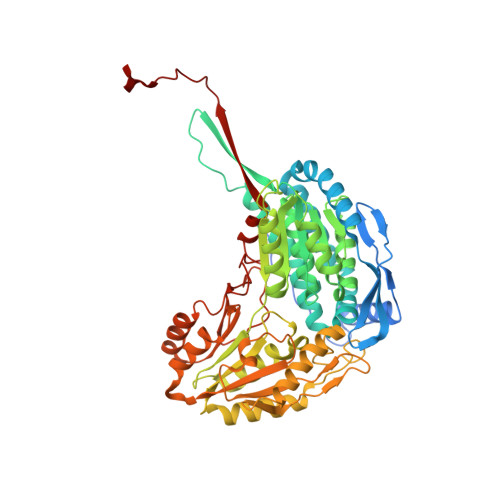Structural basis of substrate selectivity of Delta (1)-pyrroline-5-carboxylate dehydrogenase (ALDH4A1): Semialdehyde chain length.
Pemberton, T.A., Tanner, J.J.(2013) Arch Biochem Biophys 538: 34-40
- PubMed: 23928095
- DOI: https://doi.org/10.1016/j.abb.2013.07.024
- Primary Citation of Related Structures:
4LGZ, 4LH0, 4LH1, 4LH2, 4LH3 - PubMed Abstract:
The enzyme Δ(1)-pyrroline-5-carboxylate (P5C) dehydrogenase (aka P5CDH and ALDH4A1) is an aldehyde dehydrogenase that catalyzes the oxidation of γ-glutamate semialdehyde to l-glutamate. The crystal structures of mouse P5CDH complexed with glutarate, succinate, malonate, glyoxylate, and acetate are reported. The structures are used to build a structure-activity relationship that describes the semialdehyde carbon chain length and the position of the aldehyde group in relation to the cysteine nucleophile and oxyanion hole. Efficient 4- and 5-carbon substrates share the common feature of being long enough to span the distance between the anchor loop at the bottom of the active site and the oxyanion hole at the top of the active site. The inactive 2- and 3-carbon semialdehydes bind the anchor loop but are too short to reach the oxyanion hole. Inhibition of P5CDH by glyoxylate, malonate, succinate, glutarate, and l-glutamate is also examined. The Ki values are 0.27 mM for glyoxylate, 58 mM for succinate, 30 mM for glutarate, and 12 mM for l-glutamate. Curiously, malonate is not an inhibitor. The trends in Ki likely reflect a trade-off between the penalty for desolvating the carboxylates of the free inhibitor and the number of compensating hydrogen bonds formed in the enzyme-inhibitor complex.
Organizational Affiliation:
Department of Chemistry, University of Missouri-Columbia, Columbia, MO 65211, USA.
















